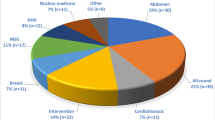Abstract
It is essential to predict the long-term supply and demand for the number of radiologic technologists as medical resources. However, it is difficult to predict the number of Japanese radiologic technologists due to complex and intertwining factors. Our purpose in this study was to predict the future number of radiologic technologists using the concept of system dynamics (SD), and to clarify the effects of relevant factors. In order to estimate the number of Japanese radiologic technologists, we constructed a flow diagram using the concept of SD. We simulated the number of radiologic technologists for the following 4 cases: maintaining the status quo, a change in the pass rate for the national examination, a change in the post-graduate employment rate, and a change in the rate of continuing education. The result for the predicted number of radiologic technologists was 50,509 in 20 years, which is 4,394 (9.5 %) more than the present number, and 50,166 in 40 years, which is 4,051 (8.8 %) more than the present number. For the factors influencing the number of technologists, the influence of the pass rate on the national examination and that of the rate for post-graduate employment was larger than that of the rate of continuing education in graduate school. The number of Japanese radiologic technologists will increase until 2033 and decrease until 2042, and it does not change after 2042 in case of maintaining the status quo. Implementing the concept of SD allowed us easily to clarify the factors influencing the predicted number of radiologic technologists.






Similar content being viewed by others
References
Richard M. Friedenberg: the role of the Super technologist. Radiology. 2000;215:630–3.
The Japanese Ministry of Health, Labor and Welfare: The team approach to healthcare. http://www.mhlw.go.jp/shingi/2010/03/dl/s0319-9a.pdf.
The Japanese Ministry of Education, Science, Sports and Culture: the Japanese government policies in education, science, sports and culture 1996. http://www.mext.go.jp/b_menu/hakusho/html/hpad199601/hpad199601_2_126.html.
The Japanese Health and Welfare Statistics Association: Annual Statistical Report of National Health Conditions 1985, Tokyo. 1985.
The Japanese Ministry of Health, Labor and Welfare: Survey of Medical Institutions & Hospital Report 2009. http://www.mhlw.go.jp/toukei/saikin/hw/iryosd/09/index.html.
The Council of Schools of Radiological technologist: Data on the school enrollment rate and the employment rate 2011.
Royston G, Dost A, Townshend J, Turner H. Using system dynamics to help develop and implement policies and programmes in health care in England. Syst Dyn Rev. 1999;15:293–313.
Joyce CM, McNeil JJ, Stoelwinder JU. More doctors, but not enough—Australian medical workforce supply 2001–2012. Med J Aust. 2006;184:441–6.
Mills MD, Thornewill J, Esterhay RJ. Future trends in the supply and demand for radiation oncology physicists. J Appl Clin Med Phys. 2010;11:209–19.
Chung SH, Jung DC, Yoon SN, Lee DH. A dynamic forecasting model for nursing manpower requirements in the medical service industry. Serv Bus. 2010;4:225–36.
Barber P, López-Valcárcel BG. Forecasting the need for medical specialists in Spain: application of a system dynamics model. Human Resources for Health. 2010;8:24.
Kaneko R, Ishikawa A, Ishii F, et al. Population projection for Japan: 2006–2055 outline of results, methods, and assumptions. Japanese J Population. 2008;6:76–114.
The Japanese Association of Radiological Technologists. Authorized Qualification. [http://www.jart.jp/english/life_study.html].
Japan Pharmaceutical Association: the 6 year programs for pharmacist education [http://www.pharm.or.jp/kyoiku/pdf/monka_1905.pdf].
Japanese Nursing Association: Midwifery in Japan. [http://www.nurse.or.jp/jna/english/midwifery/pdf/mij2011.pdf].
Yamamoto N, Uchiyama M. A prediction study on the supply of and demand for pharmacists in Japan. Yakugaku Zasshi. 2002;122:309–21.
Homer JB, Hirsch GB. SM: system dynamics modeling for public health. Am J Public Health. 2006;96:452–8.
Trcek D. Using systems dynamics for human resources management in information systems security. Kybernetes 2006;35(7–8):1014–23.
Barber P, López-Valcárcel BG. Forecasting the need for medical specialists in Spain: application of a system dynamics model. Hum Resour Health. 2010;8:24.
Ishikawa T, Yokooka Y, Ohba H, Ogasawara K: Forecasting the absolute and relative shortage of physicians in Japan using a system dynamics model approach. Hum Resour Health, submitted.
Acknowledgments
The authors declare that they have no conflict of interest.
Author information
Authors and Affiliations
Corresponding author
Appendix: system dynamics [17–20]
Appendix: system dynamics [17–20]
System dynamics (SD) is a methodology and computer simulation modeling technique for framing, understanding, and discussing complex issues and problems. This method was invented by Professor JW, Forrester of the Massachusetts Institute of Technology in 1956 for predicting business activities [17]. It addresses people, processes, and material and information flows by exposing a tenet of all complex systems—feedback loops. According to SD, these loops are the major drivers of system behavior. This methodology also enables us to address non-linear SD, which governs many real-life phenomena [17]. The approach has been used in a variety of contexts, including human resources planning, to gain an understanding of a system with complex dynamic and nonlinear interacting variables [18, 19]. Internal feedback systems are represented in the SD model. The model is an interlocking set of differential algebraic equations developed from a broad spectrum of relevant measured and experiential data [17].
A causal loop diagram identifies the structures and interaction of feedback loops, and consists of variables for causal links. A causal link connects a cause variable with an effect variable by a link with a positive or negative change. To construct the radiologic technologist supply model, we based the causal loop on the career path of radiologic technologist (Fig. 1).
System accumulation is described by stock (or level) variables, such as the number of radiologic technologists, whereas the rate of change is described by flow variables, such as the annual number of radiologic technologists who retire. The net inflow determines the rate of stock change, i.e., its time derivative. Therefore, the interaction between stock and flow is calculated mathematically by the differential equation below. In the equation, inflow and outflow denote the values of the inflow and outflow at any time between the initial time and the present time t.
About this article
Cite this article
Araseki, M., Yokooka, Y., Ishikawa, T. et al. The number of Japanese radiologic technologists will be increased in 40 years. Radiol Phys Technol 6, 467–473 (2013). https://doi.org/10.1007/s12194-013-0220-7
Received:
Revised:
Accepted:
Published:
Issue Date:
DOI: https://doi.org/10.1007/s12194-013-0220-7




